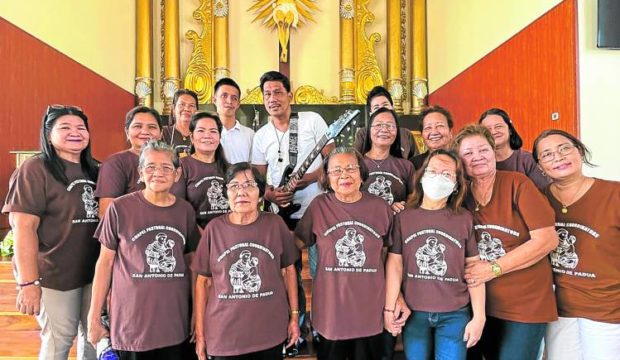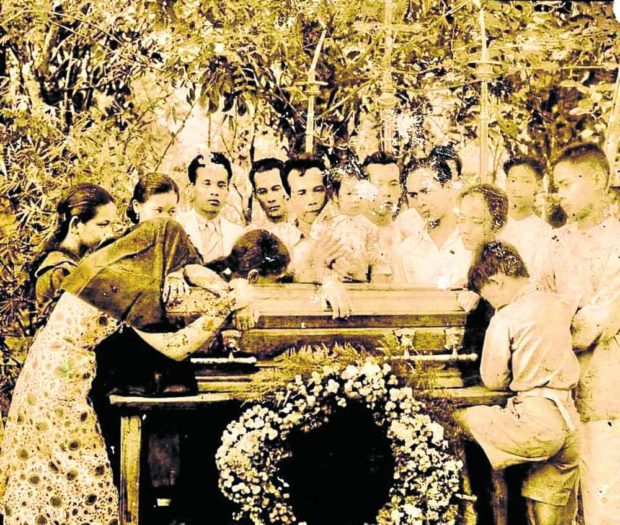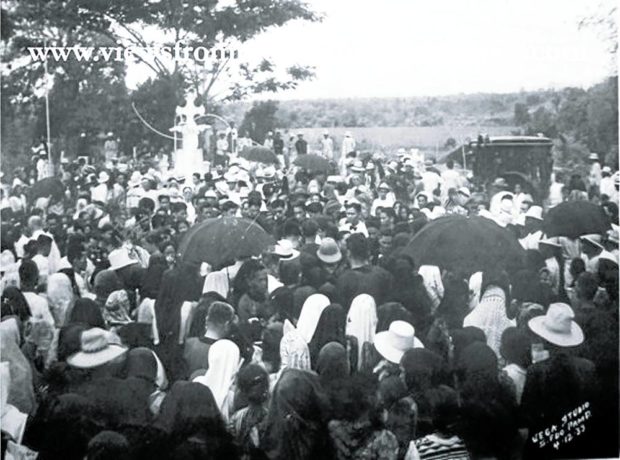Pampanga’s ritual for the dead lives on

A group of singers performs the “gosu,” a set of hymns and prayers for the saints and souls, that is a continuing tradition at Barangay San Antonio in Mexico town before “Undas” or “daun.” (Photos from the collections of ROBBY TANTINGCO and ALEX R. CASTRO and by TONETTE OREJAS)
MEXICO, Pampanga, Philippines — Gosu, an old Kapampangan tradition of making the rounds of homes to sing hymns and prayers for saints and souls, is still alive in a village in this town just east of the urban capital San Fernando.
San Antonio could be the first among Pampanga villages to have resumed the gosu as early as Oct. 12, or about three years into the COVID-19 pandemic, the prince of Kapampangan poets and gosu composer Romeo Rodriguez confirmed to the Inquirer.
The tradition was dying before the pandemic struck because fewer villages kept up with it, Rodriguez said.
Gosu has also been revived since last week in Barangays San Francisco and San Vicente in coastal Masantol town; in Matamo in the mountain town of Arayat; and in Pulung Masle, a farming village in Guagua town, according to liturgical music composer and former Catholic priest Cris Cadiang.
“I was told a traveling troupe doing gosu has stopped going around Masantol this time,” Cadiang said.
Article continues after this advertisement
EXPRESSIONS OF GRIEF Shows how early Kapampangans express grief, with a mother mourning the death of her daughter in Mabalacat, Pampanga, in the 1950
Riverside
Councilor Marcelo Lacap Jr. said gosu was monitored this week in Masantol’s Barangay San Agustin-Sta. Monica Caingin at the right bank of the downstream Pampanga River as well as in Barangay Bagang on the river’s left bank.
Article continues after this advertisement“These maggogosu sing in adjacent villages,” Lacap said.
The Holy Angel University Center for Kapampangan Studies (CKS) is still verifying whether the gosu has been restarted in places where it used to be done like in the villages of San Pablo, San Lorenzo, Balas and San Jose Matulid in Mexico town; Bulacus in Masantol town; Betis and Rizal in Guagua town; Pio in Porac town; and Bulaon, Del Carmen, Baliti and Panipuan in the capital city of San Fernando.
Robert Tantingco, CKS director, said no colonial-era papers wrote about the origin or purpose of gosu.
“It seemed that cultural practices were not recorded then, only historical events were documented,” he observed.
Tantingco added: “The gosu must have been brought here from Spain because gosu/gozo started there.”
It is not known how gosu exactly compares with the Tagalog’s pangangaluluwa (halloween).Health risks
Rodriguez said the maggogosu, most of whom are elderly, must have stopped doing the tradition because they were afraid of getting infected or killed by COVID-19.
For Tantingco, “the pandemic totally disrupted and halted the practice because of social distancing and curfew.”
Other cultural practices like the Aguman Sanduk (brotherhood of the Ladle) in Minalin; Libad ng Apung Iru (fluvial procession of St. Peter) in Apalit; Lubenas (street parade of hand-held Christmas lanterns) in Angeles and Mabalacat cities, and Magalang town; Majigangga (street parade of giant puppets) in Sta. Ana town; and Kuraldal (trance-like dancing) in Sasmuan town were put off, he said.
The present-day version of gosu in San Antonio, as documented by the Inquirer on Oct. 26, consisted of seven songs with 14 to 24 stanzas, including the pamuclat (introduction) and pamun (permission of house owners to recite prayers).
This gosu choir is made up of 27 women and two men, whose ages range from 37 to 77 and hail from all the village’s six sitios. The lone male guitarist, Oden Gozun, accompanied them through five melodies, each using only four chords. He said he could indulge in the devotion because he lives on a regular salary as a local government employee.
Belonging to the San Antonio de Padua chapel for Catholic believers, the choir devoted 18 days to the gosu, ending it on Oct. 29 with a “Living Rosary” (people standing together as beads and reciting the mysteries loudly).

A burial rite in Candaba town in the 1920s that drew hundreds of people.
Not scary
The maggogosu go around the village in white shirts and denim pants, never in ghoulish costumes.
They announced home visits in advance via letters, but they did not pelt stones on stingy people’s houses or steal chickens, fruits or anything else from the backyard. They accept cash, food or anything that can be shared.
Taking four to five minutes to complete one song with a prayer, the choir is able to cover 25 homes every night, rain or shine, said chapel pastoral council president Gloria Gozun, 60.
She said a song or more can be heard, depending on the request of the head of the family.
The gosu on the life of St. Monica is unique in that the choir is split into two, singing alternately.
The longest gosu in San Antonio is about the crusade of the Virgen de los Remedios and the miracles attributed to her crusade of charity in the province. The gosu on St. Peter the Apostle narrated his manifestations in Apalit town.
Every song ended with, “Ngeni pu mepupus na ya/ Ining gosu ming darala/Ngeni pu pangadian mi ya/Ibpa Mi at Bapu Maria (Now that it is finished/This gosu that we bring you/Now we pray/Our Father and Hail Mary).”
Vow, function
The leader concluded it further by reciting, “Ding caladua ra ding sablang tapat king Dios/pauli ning keyang pacalulu/ manatili la saking catahimikan (May the souls of all those faithful to God/because of mercy/remained in peace).” The choir answered back with a loud, emphatic “Amen.”
The gosu survived in San Antonio because it was a “panata para karing meangubie” (vow for the dearly departed), Gozun said.
It also lived on because the gosu has a function of raising funds to pay for the musical band that would play during the lubenas, or the nine-day Christmas dawn Masses, explained the chapel’s treasurer, Irene Capulong.
“We have a record of limus (contributions of food or money from homes that were visited),” Capulong, 70, said.
The chapel, which was built a year ago, looked grand, making it proof of the generosity or religious nature of the villagers.
In the 1970s, the maggogosu received ingredients for arroz caldo (porridge) or pancit (noodles).“It was food for all,” Capulong recalled, adding that when money was pooled, candles for the dead were bought and lit at the Sta. Monica parish church.
The San Antonio choir brings the gosu occasionally to nearby villages.
Learning from elders
The lyrics have been preserved because some elderly people wrote and compiled the gosu in ordinary notebooks. The current choir copied and typed these on bond papers secured in yellow plastic folders, said Gozun, 60.
In her case, she learned the melodies, rhythm, and lyrics from the late Eliseo Gonzales and his wife, Trinidad.
However, there was no formal training then or now, Gozun said.
Jonathan Panganiban, the chapel’s coordinator and the youngest at 37, was exposed to gosu through his mother, Dina.
Oden Gozun, 49, trained as a guitarist and a polosador (one who sings extemporaneously about slices of life or events) under his father, Cornelio.
The gosu in San Antonio was stopped in 2020 and 2021 because of restrictions on the movements of the elderly during the COVID-19 pandemic, Panganiban said.
The women who came to the practice on Oct. 27 — Gloria Gozun; Capulong; Gloria Bulacsao, 76; Janeth David, 58; Violeta Matic, 74; Cristina Canda, 50; Emy Mallari, 56; Lucia Fabian, 58; Merly Manalang, 54; Beth Asuncion, 67; Victoria Bernardo, 77; Rosana Villegas, 59; Dina Panganiban, 59; and Tess Cayanan, 58 — agreed that the challenge now is to teach gosu to young people to be able to sustain the tradition.
‘Intact, tangible’
“I appreciate [the gosu in San Antonio] because it is an intact and tangible tradition,” said Rae Louis Maglaqui, chair of the communications department at Angeles University Foundation. A resident in the same village, he grew up hearing it during daun (feasts of saints and dead), mistaking it to be part of a religious crusade.
Maglaqui, 32, has been posting photos and videos of gosu to make the tradition known to netizens.
Popularizing the gosu began a decade ago. CKS published the book, “Gale at Gosu,” by Cadiang in 2012, who granted “umbrella permission” to anyone who wishes to use any of the 175 gosu he composed.
CKS also published Joel Mallari’s “Serenata (A Treasury of Kapampangan Folk Songs),” which included a musical annotation of the gosu’s first two stanzas.
The center added a few elements of gosu to its revised Halloween event on Oct. 24. Grade school students wore costumes of Catholic saints, went the rounds of offices asking for food and praying for the souls of departed relatives of university employees.
Adonis Salas, San Antonio village chief, said the gosu should be continued as a “church-based tradition to be able to deepen the Catholic faith and keep praying for our deceased loved ones.”
According to Cadiang, the ways of honoring the dead are many now, which must be why younger people do not rely anymore on gosu.